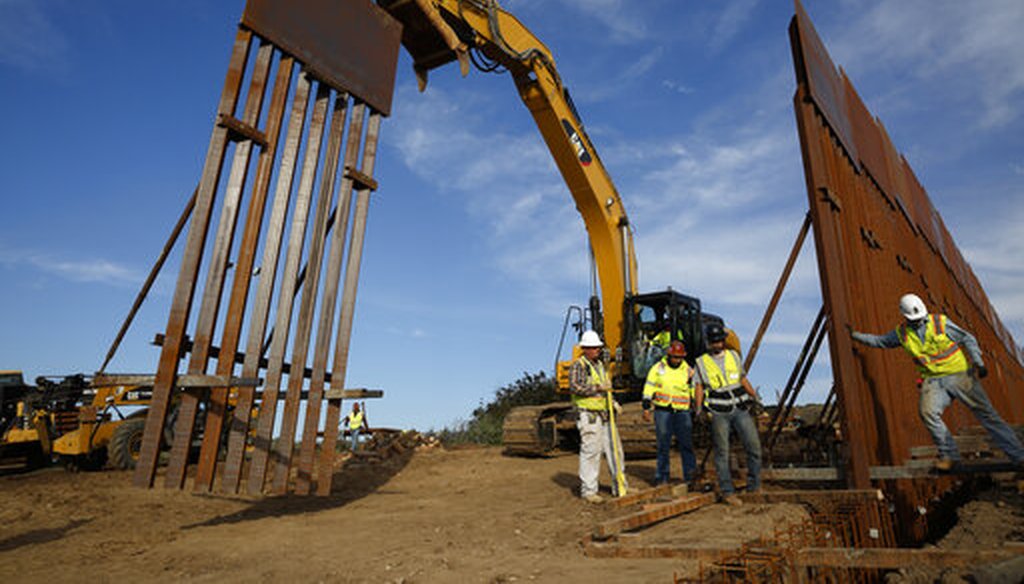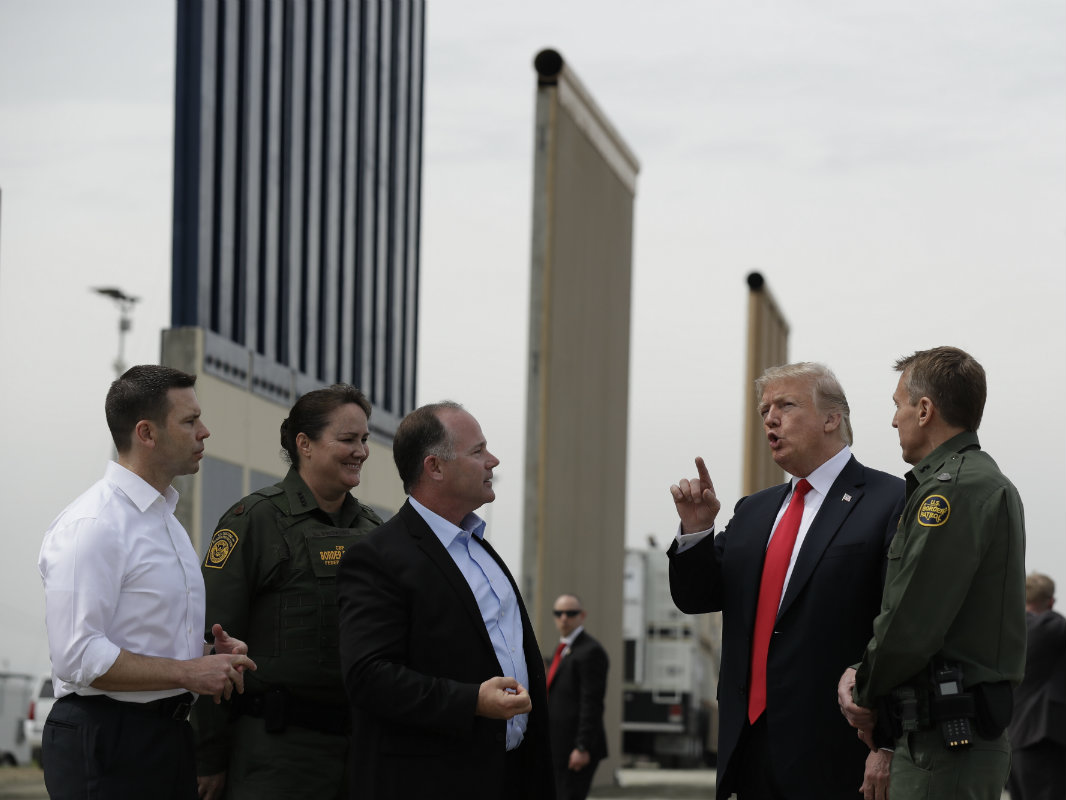Stand up for the facts!
Our only agenda is to publish the truth so you can be an informed participant in democracy.
We need your help.
I would like to contribute

In this Jan. 9, 2019 file photo, construction crews install new border wall sections seen from Tijuana, Mexico. The government is working on replacing and adding fencing in various locations. (AP)
The U.S.-Mexico border wall is getting built, President Donald Trump often claims. Construction is happening, he says, in spite of reluctance from Congress. And lately, Trump has attached a recurring figure to illustrate how far along he’s come on his big promise.
"You see the hell we are going through trying to get the wall," he said in Panama City Beach, Fla., May 8. "We’re going to have over 400 miles of wall built, much of it is already started, by the end of next year, and we’ll conclude it pretty shortly thereafter. We’ll have the whole thing sealed up and it will be a lot easier."
Trump in April repeated versions of this 400-mile talking point at an immigration meeting in California, on Twitter, and at a National Rifle Association event in Indiana.
"The Democrats are also working hard to block the wall, but we are building the wall. They’re not happy about it. And we will have over 400 miles of wall built by the end of next year," Trump told the NRA in late April. "Any politician would’ve given up a long time ago. … We’re also renovating tremendous stretches of wall. We have wall that’s in bad shape, but it’s structurally sound. And rather than building new, we renovate it. We make it as good as new, save a lot of money, and we gain a lot of territory."
For perspective, the U.S.-Mexico border spans nearly 2,000 miles. About 650 miles of fencing was already in place before Trump began promising on the campaign trail a border wall paid for by Mexico.
Sign up for PolitiFact texts
To someone not paying close attention, it may sound like Trump is well on his way to covering more ground. But Trump is not advancing hundreds of miles of construction where there was no barrier before. As he sometimes mentions in passing, there are border projects that reinforce or replace existing barriers.
These structures are harder to get through than some of their predecessors. But they are not the "impenetrable" structure he pushed in the campaign. The wall prototypes he ordered built are not being used the border because they did not meet all requirements.
Trump has drawn federal dollars toward this campaign pledge. But Mexico is still not paying.
The administration has secured funding for about 260 miles. His fiscal year 2020 budget plan asked for additional money for about 200 miles, but it’s not clear how many of those miles would have barriers for the first time.
Based on the information we gathered as of mid May, we don’t know whether 400 miles of barriers will be added by 2020, or exactly how much of what's planned and in progress will be new or a replacement. We could not verify start and completion dates for many of the projects or when some contracts will be awarded.
Complicating matters more is the fact that some of the information Customs and Border Protection has provided is vague, inconsistent and incomplete. For instance, the agency describes some projects as "new border wall," echoing Trump’ suggestion, but it does not specify if that means new miles of border wall or new structures on land with existing barriers.
PolitiFact asked the agency to clarify its information, but we did not hear back by deadline. So here’s what we know about the latest iteration of Trump’s wall boast.
(President Donald Trump reviews border wall prototypes in San Diego, March 13, 2018. Evan Vucci /AP)
Overall, parts of the border are getting a "bollard wall" of concrete-filled steel posts as high as 30-feet, with gaps in between, and with a plate at the top to deter scaling (photo). Levee walls — concrete walls with 18-feet tall steel posts on top of the concrete — are also under construction. (Here’s a 2013 photo of a version of a levee wall.)
CBP describes some projects as a "border wall system" or "levee wall system," that refers to construction that includes roads, lighting, enforcement cameras, and other technology. The agency sent us a list of plans funded a variety of ways: through 2017, 2018 and 2019 fiscal year allocations to CBP from Congress, and by funds from the departments of Treasury and Defense.
• 40 miles of bollard wall in San Diego, El Centro and El Paso border patrol sectors, replacing existing primary barriers. Progress: Expected to finalize May 2019.
• 14 miles of secondary bollard wall in San Diego, replacing existing secondary barriers. Progress: Construction started; completion date not provided.
• 13 miles of "new border wall system and levee wall system" in the Rio Grande Valley sector. It’s unclear if or how much of this is added mileage of barriers, or replacement of existing structures. Progress: Construction started; completion date not provided.
• 12 miles of "new border wall system" in the Rio Grande Valley sector. It’s unclear if or how much of this is added mileage of barriers, or replacement of existing structures. Progress: Contract expected to be awarded by September 2019; completion date not provided.
• 41 miles of border wall in San Diego and Calexico, Calif., and Yuma, Ariz. It’s unclear if or how much of this is added mileage of barriers, or replacement of existing structures. Progress: Without parsing out details, CBP said contracts had been awarded and that construction began in April 2019; completion dates not provided.
• 85 miles in the Rio Grande Valley sector, comprised of about 11 miles of "primary levee wall system" and 74 miles of "new border wall system." It’s unclear if or how much of this is added mileage of barriers, or replacement of existing structures. (Using CBP and Treasury funds.) Progress: CBP did not say whether contracts had been awarded nor state a construction timeline.
• Up to 53 miles of "new bollard wall," replacing existing barriers. (Using Defense funds.) Progress: CBP did not say whether contracts had been awarded nor state a construction timeline.
While Trump’s fiscal year 2020 budget proposal included a request for about 200 miles of barriers, with Democrats in control of the House, it’s uncertain if Trump would get money for these projects.
Note: We found other projects to replace existing barriers that Customs and Border Protection did not include in its list (including an upgrade in New Mexico that Trump previously touted as wall construction).
All told, it is true that there is construction going on at the border. But it’s important to know that it includes the replacement of existing barriers that officials consider to be outdated or no longer effective in stopping illegal immigration. The Trump administration hasn’t made clear how many more miles of the border will have some sort of barrier by the end of 2020, despite what the president says.
Also, Mexico has not agreed to pay for the construction, despite Trump’s campaign promise to get the neighboring country to pay for the costs.
It’s uncertain how much more money Congress will authorize for the barriers — or how Trump might try to secure more funding on his own.
Our Sources
Twitter, @realdonaldtrump tweet, April 5, 2019
Donald Trump campaign rally in Florida, May 8, 2019
Email interview, U.S. Customs and Border Protection, May 9, 2019
WhiteHouse.gov, Remarks by President Trump at the NRA-ILA Leadership Forum | Indianapolis, IN, April 26, 2019; Remarks by President Trump in Roundtable on Immigration and Border Security | Calexico, California, April 5, 2019
Homeland Security Digital Library, SECURING THE BORDER:FENCING,INFRASTRUCTURE, AND TECHNOLOGY FORCE MULTIPLIERS, May 13, 2015
Flickr.com, U.S. Customs and Border Protection photo for border barrier, taken April 6, 2018; levee wall photos, taken Sept. 21, 2013
DHS.gov, Walls Work, Dec. 12, 2018
CBP.gov, San Diego Secondary Wall Construction to Begin, Feb. 18, 2019
CBP.gov, Rio Grande Valley Levee Wall System Construction Start, April 4, 2019; Border Wall Construction Project to Begin in Texas, Nov. 2, 2018
PolitiFact, Donald Trump leaves out part of the story with New Mexico border barrier, Feb. 25, 2019
Congressional Research Service, Border Security Between Ports of Entry:Homeland Security Issues in the 116th Congress, updated Feb. 11, 2019



 PolitiFact Rating:
PolitiFact Rating: 









































